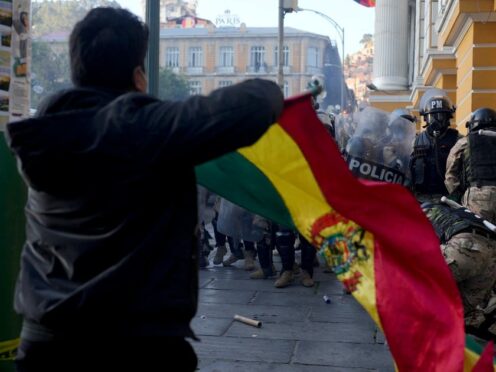
Armoured vehicles rammed into the doors of Bolivia’s government palace in La Paz on Wednesday in an apparent coup attempt, but President Luis Arce vowed to stand firm and named a new army commander who ordered troops to stand down.
The soldiers pulled back along with a line of military vehicles as hundreds of Mr Arce’s supporters rushed to the square outside the palace, waving Bolivian flags and cheering.
Mr Arce, surrounded by ministers, waved at the throngs of supporters who sung the national anthem.
“Thank you to the Bolivian people,” he said. “Let democracy live on.”

Hours later, the Bolivian general who appeared to be behind the rebellion, Juan Jose Zuniga, was arrested after the attorney general opened an investigation against him.
Wednesday’s rebellion followed months of tensions, with economic hardship and protests growing as Mr Arce and his one-time ally, leftist former president Evo Morales, battle for control of the ruling party.
The apparent attempt to depose the sitting president appeared to lack any meaningful support and even Mr Arce’s rivals closed ranks to defend democracy and repudiate the uprising.
The spectacle outraged regional leaders and shocked Bolivians, who was no stranger to political unrest. In 2019 Mr Morales was ousted as president following an earlier political crisis.
As the crisis unfolded on Wednesday, military vehicles flooded into the plaza.
Before entering the government building, Mr Zuniga told journalists: “Surely soon there will be a new cabinet of ministers; our country, our state cannot go on like this.”
He said that “for now” he recognised Mr Arce as commander in chief.
Mr Zuniga did not explicitly say he was leading a coup, but in the palace, with bangs echoing behind him, he said the army was trying to “restore democracy and free our political prisoners”.
Shortly after, Mr Arce confronted Mr Zuniga in the palace hallway, as shown on video on Bolivian television.
“I am your captain, and I order you to withdraw your soldiers, and I will not allow this insubordination,” Mr Arce demanded.
Surrounded by ministers in the palace, the Bolivian leader said: “Here we are, firm in Casa Grande, to confront any coup attempt. We need the Bolivian people to organise.”
He added in a video message that he would not “allow, once again, coup attempts to take the lives of Bolivians”.
Less than an hour later, Mr Arce announced new heads of the army, navy and air force amid the roar of supporters, and thanked the country’s police and regional allies for standing by him. Mr Arce said the troops who rose against him were “staining the uniform” of the military.
“I order all that are mobilised to return to their units,” said the newly named army chief Jose Wilson Sanchez. “No one wants the images we’re seeing in the streets.”
Shortly after the armoured vehicles roared out of the plaza, tailed by hundreds of military fighters, police in riot gear set up blockades outside the government palace.

The incident was met with a wave of outrage by other regional leaders, including the Organisation of American States, Gabriel Boric, the president of neighbouring Chile, the leader of Honduras and former Bolivian leaders.
An American defence official said the United States “is closely monitoring” the situation in Bolivia and urges calm.
Bolivia, a country of 12 million people, has seen intensifying protests in recent months over the economy’s precipitous decline from one of the continent’s fastest-growing two decades ago to one of its most crisis-stricken.
The country also has seen a high-profile rift at the highest levels of the governing party.
Mr Arce and his one-time ally, leftist icon and former president Evo Morales, have been battling for the future of Bolivia’s splintering Movement for Socialism, known by its Spanish acronym MAS, ahead of elections in 2025.
Following Wednesday’s chaos, reports on local media showed Bolivians stocking up on food and other essentials in supermarkets, concerned about what will come next.
But before supporters outside the presidential palace, the country’s vice president David Choquehuanca vowed: “Never again will the Bolivian people permit coup attempts.”

Enjoy the convenience of having The Sunday Post delivered as a digital ePaper straight to your smartphone, tablet or computer.
Subscribe for only £5.49 a month and enjoy all the benefits of the printed paper as a digital replica.
Subscribe